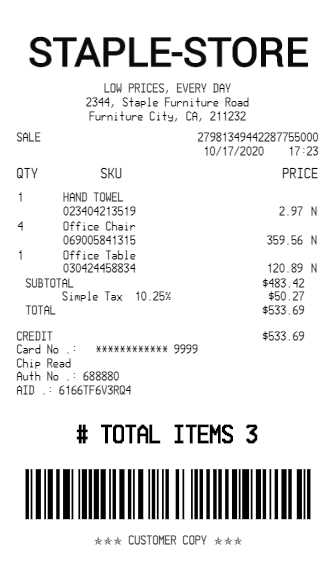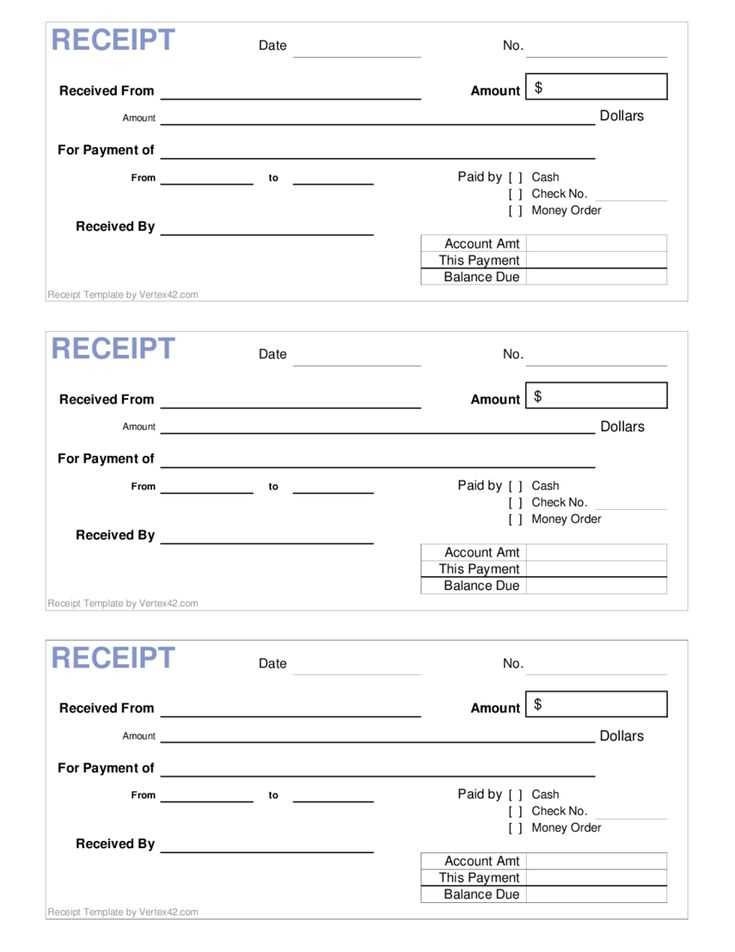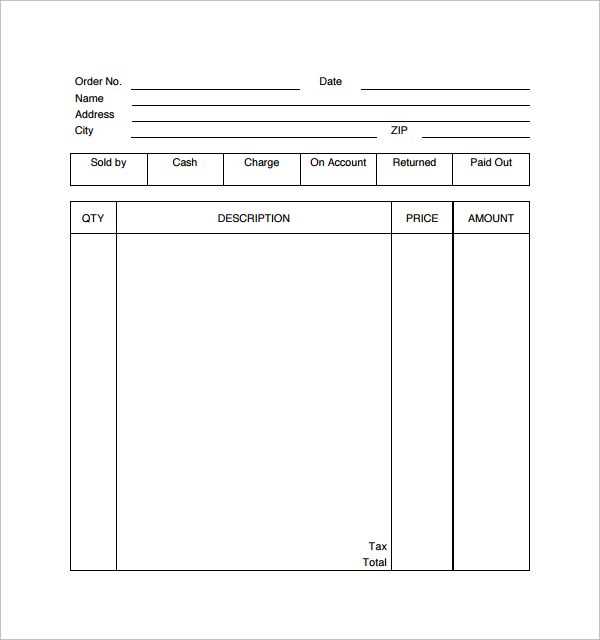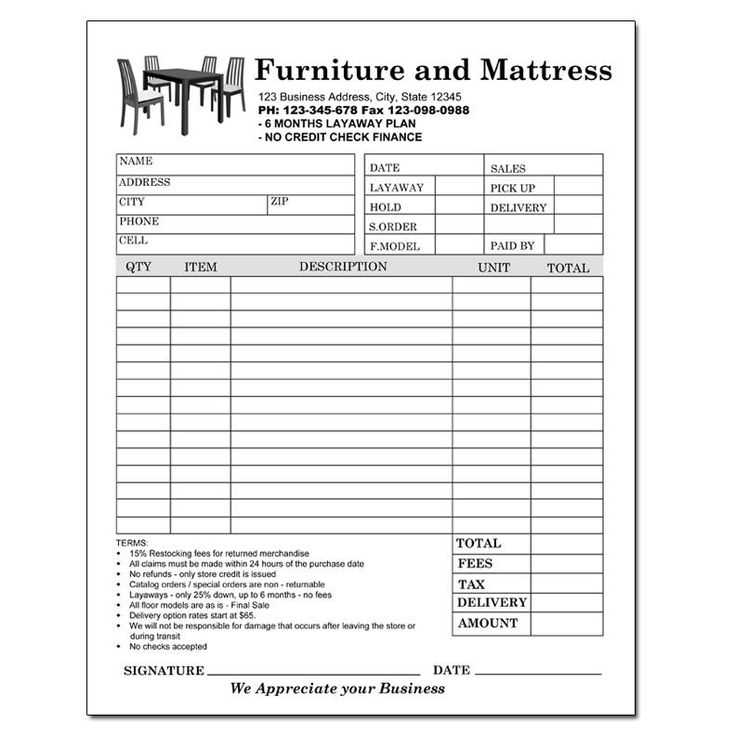
When creating a receipt template for a furniture store, clarity and simplicity should be your priorities. Start by listing key details such as the store’s name, address, and contact information at the top. This ensures that customers can easily reach out if they have questions or need assistance with their purchase.
Item descriptions should be clear and concise. Include product names, quantities, and prices to avoid confusion. If applicable, note any discounts or promotions the customer used during their purchase. Display the total amount, including taxes and delivery fees, in a bold font for easy visibility.
Adding a section for the payment method is a good idea. Whether it’s cash, credit, or debit, this provides transparency. A thank you message at the bottom of the receipt adds a personal touch and encourages customer loyalty. Finally, ensure the template is easily adaptable to fit various sale scenarios by keeping it flexible yet consistent.
Furniture Store Receipt Template
A well-structured receipt template for a furniture store should include key details such as the store name, transaction date, list of purchased items, their individual prices, applicable taxes, and the total amount due. Clear item descriptions are crucial to avoid confusion, especially for larger or custom-made furniture items.
Key Components
Each receipt must contain the following elements for clarity and legal compliance:
- Store Information: Include the store’s name, address, contact number, and website for easy reference.
- Transaction Details: List the purchase date and a unique receipt number for tracking purposes.
- Itemized List: Clearly describe each item purchased, including quantity and price per unit. For custom orders, ensure to include a description of the specifications.
- Tax Breakdown: Display the applicable sales tax, ensuring the tax rate matches local laws.
- Total Amount: Provide the final amount, including any discounts or promotions applied.
Additional Tips
For better customer experience, consider adding a section for return policies or warranty information. Providing a breakdown of payment methods (credit card, cash, etc.) can also be helpful. Keep your receipt template simple and easy to understand, avoiding unnecessary jargon.
Designing a Custom Layout for Your Receipts

Focus on creating a clean, simple structure that highlights key transaction details while keeping the layout compact. Include the most important information like store name, transaction date, items purchased, and total cost at the top for easy reference.
Use clear font choices for readability. Limit the number of fonts to two or three, sticking to one for headings and another for item details. Ensure the font size is appropriate–large enough for easy reading, but not so large that it wastes space.
Incorporate a consistent color scheme that matches your store’s branding. Use color sparingly to highlight important details such as the total amount or discounts. A subtle background color can add a professional touch without overwhelming the content.
- Store Logo: Place it at the top left corner for brand recognition.
- Item List: Organize the list in a simple table format, with clear columns for product names, quantities, prices, and subtotals.
- Subtotal and Taxes: Display them in bold for visibility.
- Footer: Use this space for return policies, contact info, and store hours.
Consider adding a QR code linking to your online store or customer survey to encourage feedback and improve customer engagement.
Ensure the receipt is printer-friendly, taking into account both the paper size and printer type. Test different formats and optimize for various devices if you’re providing digital versions.
Key Information to Include on a Receipt
Always include the store name and contact details such as address and phone number. This ensures customers know where to reach you if needed.
Clearly display the date and time of the transaction. This helps with returns or exchanges and serves as a reference for both parties.
List all items purchased with descriptions and quantities. Break down each item’s price and any applicable discounts or promotions. This ensures transparency.
Include the total amount paid, specifying any taxes. Showing the full amount, including tax breakdown, builds trust and clarity with your customers.
Provide details of any payment method, whether it’s credit, debit, or cash. This offers additional proof of the transaction.
For return and exchange purposes, add transaction or order number. It helps identify specific purchases quickly if a customer needs assistance.
Consider adding your store policy for returns and exchanges, including time limits and conditions. This ensures customers understand their rights and responsibilities.
Optimizing the Template for Easy Printing

Choose a clean, simple layout with minimal margins to maximize available space and reduce unnecessary white areas. Avoid clutter by focusing on key details: item name, price, and quantity. Use legible fonts and standard sizes, like Arial or Times New Roman, to ensure clarity when printed. This helps the text stay readable on different paper sizes without requiring adjustments.
Choose the Right Paper Size
Select a standard paper size such as A4 or Letter to ensure compatibility with most printers. Pre-configured templates often default to these sizes, but double-check to avoid misalignment when printing. This choice prevents awkward scaling issues and maintains the integrity of your design.
Test Print Before Final Use

Before sending the receipt to a printer, do a test print on a regular sheet. This helps you identify any misalignment or content that might get cut off. Adjust your margins or fonts based on the test to ensure everything fits within the printable area.


